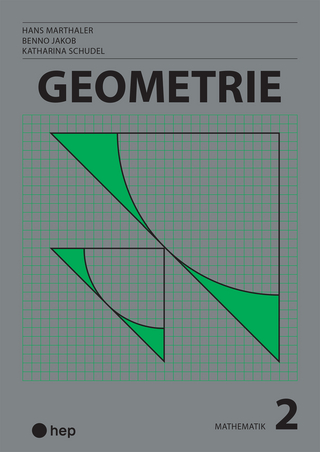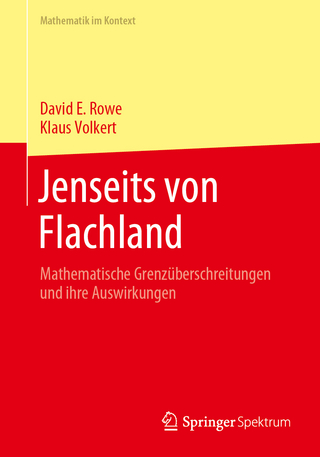
Lectures on Discrete Geometry
Springer-Verlag New York Inc.
978-0-387-95373-1 (ISBN)
This book is primarily a textbook introduction to various areas of discrete geometry. In each area, it explains several key results and methods, in an accessible and concrete manner. It also contains more advanced material in separate sections and thus it can serve as a collection of surveys in several narrower subfields. The main topics include: basics on convex sets, convex polytopes, and hyperplane arrangements; combinatorial complexity of geometric configurations; intersection patterns and transversals of convex sets; geometric Ramsey-type results; polyhedral combinatorics and high-dimensional convexity; and lastly, embeddings of finite metric spaces into normed spaces.
Jiri Matousek is Professor of Computer Science at Charles University in Prague. His research has contributed to several of the considered areas and to their algorithmic applications. This is his third book.
1 Convexity.- 1.1 Linear and Affine Subspaces, General Position.- 1.2 Convex Sets, Convex Combinations, Separation.- 1.3 Radon’s Lemma and Helly’s Theorem.- 1.4 Centerpoint and Harn Sandwich.- 2 Lattices and Minkowski’s Theorem.- 2.1 Minkowski’s Theorem.- 2.2 General Lattices.- 2.3 An Application in Number Theory.- 3 Convex Independent Subsets.- 3.1 The Erd?s-Szekeres Theorem.- 3.2 Horton Sets.- 4 Incidence Problems.- 4.1 Formulation.- 4.2 Lower Bounds: Incidences and Unit Distances.- 4.3 Point-Line Incidences via Crossing Numbers.- 4.4 Distinct Distances via Crossing Numbers.- 4.5 Point-Line Incidences via Cuttings.- 4.6 A Weaker Cutting Lemma.- 4.7 The Cutting Lemma: A Tight Bound.- 5 Convex Polytopes.- 5.1 Geometric Duality.- 5.2 H-Polytopes and V-Polytopes.- 5.3 Faces of a Convex Polytope.- 5.4 Many Faces: The Cyclic Polytopes.- 5.5 The Upper Bound Theorem.- 5.6 The Gale Transform.- 5.7 Voronoi Diagrams.- 6 Number of Faces in Arrangements.- 6.1 Arrangements of Hyperplanes.- 6.2 Arrangements of Other Geometric Objects.- 6.3 Number of Vertices of Level at Most k.- 6.4 The Zone Theorem.- 6.5 The Cutting Lemma Revisited.- 7 Lower Envelopes.- 7.1 Segments and Davenport-Schinzel Sequences.- 7.2 Segments: Superlinear Complexity of the Lower Envelope.- 7.3 More on Davenport-Schinzel Sequences.- 7.4 Towards the Tight Upper Bound for Segments.- 7.5 Up to Higher Dimension: Triangles in Space.- 7.6 Curves in the Plane.- 7.7 Algebraic Surface Patches.- 8 Intersection Patterns of Convex Sets.- 8.1 The Fractional Helly Theorem.- 8.2 The Colorful Carathéodory Theorem.- 8.3 Tverberg’s Theorem.- 9 Geometric Selection Theorems.- 9.1 A Point in Many Simplices: The First Selection Lemma.- 9.2 The Second Selection Lemma.- 9.3 Order Types and the Same-Type Lemma.- 9.4 A Hypergraph Regularity Lemma.- 9.5 A Positive-Fraction Selection Lemma.- 10 Transversals and Epsilon Nets.- 10.1 General Preliminaries: Transversals and Matchings.- 10.2 Epsilon Nets and VC-Dimension.- 10.3 Bounding theVC-Dimension and Applications.- 10.4 Weak Epsilon Nets for Convex Sets.- 10.5 The Hadwiger-Debrunner (p, q)-Problem.- 10.6 A (p, q)-Theorem for Hyperplane Transversals.- 11 Attempts to Count k-Sets.- 11.1 Definitions and First Estimates.- 11.2 Sets with Many Halving Edges.- 11.3 The Lovász Lemma and Upper Bounds in All Dimensions.- 11.4 A Better Upper Bound in the Plane.- 12 Two Applications of High-Dimensional Polytopes.- 12.1 The Weak Perfect Graph Conjecture.- 12.2 The Brunn-Minkowski Inequality.- 12.3 Sorting Partially Ordered Sets.- 13 Volumes in High Dimension.- 13.1 Volumes, Paradoxes of High Dimension, and Nets.- 13.2 Hardness of Volume Approximation.- 13.3 Constructing Polytopes of Large Volume.- 13.4 Approximating Convex Bodies by Ellipsoids.- 14 Measure Concentration and Almost Spherical Sections.- 14.1 Measure Concentration on the Sphere.- 14.2 Isoperimetric Inequalities and More on Concentration.- 14.3 Concentration of Lipschitz Functions.- 14.4 Almost Spherical Sections:The First Steps.- 14.5 Many Faces of Symmetric Polytopes.- 14.6 Dvoretzky’s Theorem.- 15 Embedding Finite Metric Spaces into Normed Spaces.- 15.1 Introduction: Approximate Embeddings.- 15.2 The Johnson-Lindenstrauss Flattening Lemma.- 15.3 Lower Bounds By Counting.- 15.4 A Lower Bound for the Hamming Cube.- 15.5 A Tight Lower Bound via Expanders.- 15.6 Upper Bounds for ??-Embeddings.- 15.7 Upper Bounds for Euclidean Embeddings.- What Was It About? An Informal Summary.- Hints to Selected Exercises.
| Erscheint lt. Verlag | 2.5.2002 |
|---|---|
| Reihe/Serie | Graduate Texts in Mathematics ; 212 |
| Zusatzinfo | XVI, 486 p. |
| Verlagsort | New York, NY |
| Sprache | englisch |
| Maße | 155 x 235 mm |
| Themenwelt | Mathematik / Informatik ► Mathematik ► Geometrie / Topologie |
| ISBN-10 | 0-387-95373-6 / 0387953736 |
| ISBN-13 | 978-0-387-95373-1 / 9780387953731 |
| Zustand | Neuware |
| Haben Sie eine Frage zum Produkt? |
aus dem Bereich


